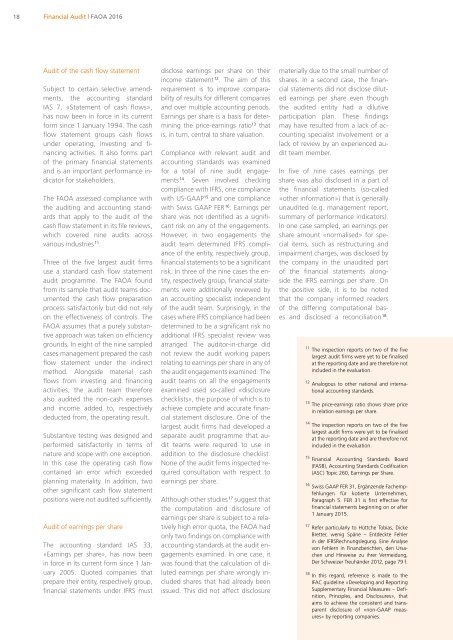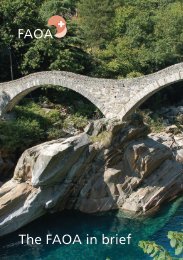Annual Report 2016
Annual Report 2016 - Federal Audit Oversight Authority FAOA
Annual Report 2016 - Federal Audit Oversight Authority FAOA
- No tags were found...
You also want an ePaper? Increase the reach of your titles
YUMPU automatically turns print PDFs into web optimized ePapers that Google loves.
18<br />
Financial Audit | FAOA <strong>2016</strong><br />
Audit of the cash flow statement<br />
Subject to certain selective amendments,<br />
the accounting standard<br />
IAS 7, «Statement of cash flows»,<br />
has now been in force in its current<br />
form since 1 January 1994. The cash<br />
flow statement groups cash flows<br />
under operating, investing and financing<br />
activities. It also forms part<br />
of the primary financial statements<br />
and is an important performance indicator<br />
for stakeholders.<br />
The FAOA assessed compliance with<br />
the auditing and accounting standards<br />
that apply to the audit of the<br />
cash flow statement in its file reviews,<br />
which covered nine audits across<br />
various industries 11 .<br />
Three of the five largest audit firms<br />
use a standard cash flow statement<br />
audit programme. The FAOA found<br />
from its sample that audit teams documented<br />
the cash flow preparation<br />
process satisfactorily but did not rely<br />
on the effectiveness of controls. The<br />
FAOA assumes that a purely substantive<br />
approach was taken on efficiency<br />
grounds. In eight of the nine sampled<br />
cases management prepared the cash<br />
flow statement under the indirect<br />
method. Alongside material cash<br />
flows from investing and financing<br />
activities, the audit team therefore<br />
also audited the non-cash expenses<br />
and income added to, respectively<br />
deducted from, the operating result.<br />
Substantive testing was designed and<br />
performed satisfactorily in terms of<br />
nature and scope with one exception.<br />
In this case the operating cash flow<br />
contained an error which exceeded<br />
planning materiality. In addition, two<br />
other significant cash flow statement<br />
positions were not audited sufficiently.<br />
Audit of earnings per share<br />
The accounting standard IAS 33,<br />
«Earnings per share», has now been<br />
in force in its current form since 1 January<br />
2005. Quoted companies that<br />
prepare their entity, respectively group,<br />
financial statements under IFRS must<br />
disclose earnings per share on their<br />
income statement 12 . The aim of this<br />
requirement is to improve comparability<br />
of results for different companies<br />
and over multiple accounting periods.<br />
Earnings per share is a basis for determining<br />
the price-earnings ratio 13 that<br />
is, in turn, central to share valuation.<br />
Compliance with relevant audit and<br />
accounting standards was examined<br />
for a total of nine audit engagements<br />
14 . Seven involved checking<br />
compliance with IFRS, one compliance<br />
with US-GAAP 15 and one compliance<br />
with Swiss GAAP FER 16 . Earnings per<br />
share was not identified as a significant<br />
risk on any of the engagements.<br />
However, in two engagements the<br />
audit team determined IFRS compliance<br />
of the entity, respectively group,<br />
financial statements to be a significant<br />
risk. In three of the nine cases the entity,<br />
respectively group, financial statements<br />
were additionally reviewed by<br />
an accounting specialist independent<br />
of the audit team. Surprisingly, in the<br />
cases where IFRS compliance had been<br />
determined to be a significant risk no<br />
additional IFRS specialist review was<br />
arranged. The auditor-in-charge did<br />
not review the audit working papers<br />
relating to earnings per share in any of<br />
the audit engagements examined. The<br />
audit teams on all the engagements<br />
examined used so-called «disclosure<br />
checklists», the purpose of which is to<br />
achieve complete and accurate financial<br />
statement disclosure. One of the<br />
largest audit firms had developed a<br />
separate audit programme that audit<br />
teams were required to use in<br />
addition to the disclosure checklist.<br />
None of the audit firms inspected required<br />
consultation with respect to<br />
earnings per share.<br />
Although other studies 17 suggest that<br />
the computation and disclosure of<br />
earnings per share is subject to a relatively<br />
high error quota, the FAOA had<br />
only two findings on compliance with<br />
accounting standards at the audit engagements<br />
examined. In one case, it<br />
was found that the calculation of diluted<br />
earnings per share wrongly included<br />
shares that had already been<br />
issued. This did not affect disclosure<br />
materially due to the small number of<br />
shares. In a second case, the financial<br />
statements did not disclose diluted<br />
earnings per share even though<br />
the audited entity had a dilutive<br />
participation plan. These findings<br />
may have resulted from a lack of accounting<br />
specialist involvement or a<br />
lack of review by an experienced audit<br />
team member.<br />
In five of nine cases earnings per<br />
share was also disclosed in a part of<br />
the financial statements (so-called<br />
«other information») that is generally<br />
unaudited (e.g. management report,<br />
summary of performance indicators).<br />
In one case sampled, an earnings per<br />
share amount «normalised» for special<br />
items, such as restructuring and<br />
impairment charges, was disclosed by<br />
the company in the unaudited part<br />
of the financial statements alongside<br />
the IFRS earnings per share. On<br />
the positive side, it is to be noted<br />
that the company informed readers<br />
of the differing computational bases<br />
and disclosed a reconciliation 18 .<br />
11 The inspection reports on two of the five<br />
largest audit firms were yet to be finalised<br />
at the reporting date and are therefore not<br />
included in the evaluation.<br />
12 Analogous to other national and international<br />
accounting standards.<br />
13<br />
The price-earnings ratio shows share price<br />
in relation earnings per share.<br />
14 The inspection reports on two of the five<br />
largest audit firms were yet to be finalised<br />
at the reporting date and are therefore not<br />
included in the evaluation.<br />
15 Financial Accounting Standards Board<br />
(FASB), Accounting Standards Codification<br />
(ASC) Topic 260, Earnings per Share.<br />
16 Swiss GAAP FER 31, Ergänzende Fachempfehlungen<br />
für kotierte Unternehmen,<br />
Paragraph 5. FER 31 is first effective for<br />
financial statements beginning on or after<br />
1 January 2015.<br />
17 Refer particularly to Hüttche Tobias, Dicke<br />
Bretter, wenig Späne – Entdeckte Fehler<br />
in der IFRSRechnungslegung. Eine Analyse<br />
von Fehlern in Finanzberichten, den Ursachen<br />
und Hinweise zu ihrer Vermeidung,<br />
Der Schweizer Treuhänder 2012, page 79 f.<br />
18 In this regard, reference is made to the<br />
IFAC guideline «Developing and <strong>Report</strong>ing<br />
Supplementary Financial Measures – Definition,<br />
Principles, and Disclosures», that<br />
aims to achieve the consistent and transparent<br />
disclosure of «non-GAAP measures»<br />
by reporting companies.
















